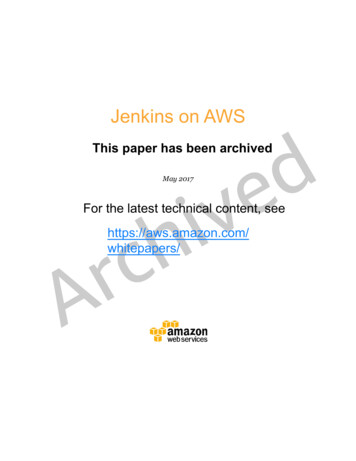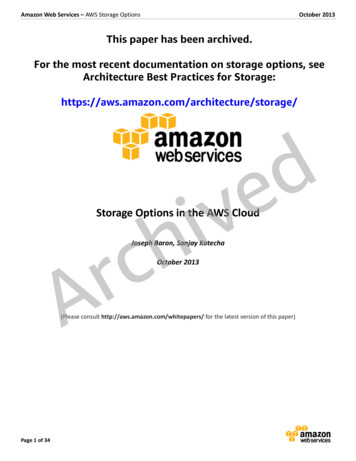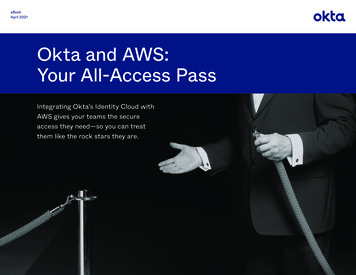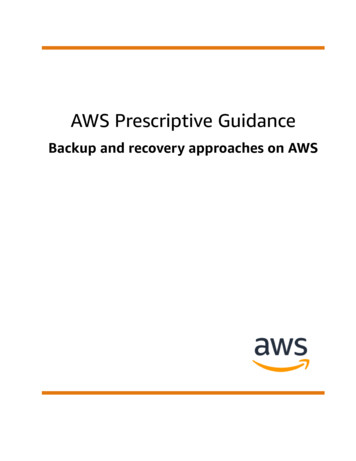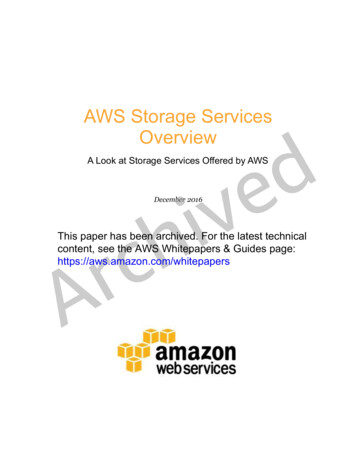
Transcription
AWS Storage ServicesOverviewdeA Look at Storage Services Offered by AWSvihDecember 2016crAThis paper has been archived. For the latest technicalcontent, see the AWS Whitepapers & Guides page:https://aws.amazon.com/whitepapers
2016, Amazon Web Services, Inc. or its affiliates. All rights reserved.NoticesThis document is provided for informational purposes only. It represents AWS’scurrent product offerings and practices as of the date of issue of this document,which are subject to change without notice. Customers are responsible formaking their own independent assessment of the information in this documentand any use of AWS’s products or services, each of which is provided “as is”without warranty of any kind, whether express or implied. This document doesnot create any warranties, representations, contractual commitments, conditionsor assurances from AWS, its affiliates, suppliers or licensors. The responsibilitiesand liabilities of AWS to its customers are controlled by AWS agreements, andthis document is not part of, nor does it modify, any agreement between AWSand its customers.crAvihde
ContentsAbstract6Introduction1Amazon S31Usage Patterns2Performance3deDurability and Availability4Scalability and ElasticitySecurity5vihInterfacesCost ModelAmazon GlacierUsage PatternscrAPerformanceDurability and AvailabilityScalability and ElasticitySecurityInterfacesCost ModelAmazon EFS567788999101111Usage Patterns12Performance13Durability and Availability15Scalability and Elasticity15Security15Interfaces16Cost Model16
Amazon EBS17Usage Patterns17Performance18Durability and Availability21Scalability and Elasticity22Security23Interfaces23deCost Model24Amazon EC2 Instance StorageUsage Patterns24vihPerformanceDurability and AvailabilityScalability and ElasticitycrASecurityInterfacesCost ModelAWS Storage GatewayUsage PatternsPerformance26272828292930303132Durability and Availability32Scalability and Elasticity32Security33Interfaces33Cost Model34AWS Snowball34Usage Patterns34Performance35Durability and Availability36
Scalability and Elasticity36Security36Interfaces37Cost Model38Amazon CloudFront39Usage Patterns39Performance40deDurability and Availability40Scalability and ElasticitySecurity40vihInterfacesCost ModelConclusioncrAContributorsReferences and Further ReadingAWS Storage ServicesOther Resources4141424243444444
AbstractAmazon Web Services (AWS) is a flexible, cost-effective, easy-to-use cloudcomputing platform. This whitepaper is designed to help architects anddevelopers understand the different storage services and features available in theAWS Cloud. We provide an overview of each storage service or feature anddescribe usage patterns, performance, durability and availability, scalability andelasticity, security, interfaces, and the cost model.crAvihde
Amazon Web Services – AWS Storage Services OverviewIntroductionAmazon Web Services (AWS) provides low-cost data storage with high durabilityand availability. AWS offers storage choices for backup, archiving, and disasterrecovery use cases and provides block, file, and object storage. In this whitepaper,we examine the following AWS Cloud storage services and features.Amazon Simple Storage ServiceA service that provides scalable and highly(Amazon S3)durable object storage in the cloud.Amazon GlacierA service that provides low-cost highlydedurable archive storage in the cloud.Amazon Elastic File SystemA service that provides scalable network(Amazon EFS)file storage for Amazon EC2 instances.vihAmazon Elastic Block StoreA service that provides block storage(Amazon EBS)volumes for Amazon EC2 instances.Amazon EC2 Instance StoragecrAAWS Storage GatewayAWS SnowballAmazon CloudFrontTemporary block storage volumes forAmazon EC2 instances.An on-premises storage appliance thatintegrates with cloud storage.A service that transports large amounts ofdata to and from the cloud.A service that provides a global contentdelivery network (CDN).Amazon S3Amazon Simple Storage Service (Amazon S3) provides developers and IT teamssecure, durable, highly scalable object storage at a very low cost.1 You can storeand retrieve any amount of data, at any time, from anywhere on the web througha simple web service interface. You can write, read, and delete objects containingfrom zero to 5 TB of data. Amazon S3 is highly scalable, allowing concurrent reador write access to data by many separate clients or application threads.Page 1
Amazon Web Services – AWS Storage Services OverviewAmazon S3 offers a range of storage classes designed for different use casesincluding the following: Amazon S3 Standard, for general-purpose storage of frequently accessed data Amazon S3 Standard-Infrequent Access (Standard-IA), for long-lived, but lessfrequently accessed data Amazon Glacier, for low-cost archival dataUsage PatternsdeThere are four common usage patterns for Amazon S3.First, Amazon S3 is used to store and distribute static web content and media.This content can be delivered directly from Amazon S3 because each object inAmazon S3 has a unique HTTP URL. Alternatively, Amazon S3 can serve as anorigin store for a content delivery network (CDN), such as Amazon CloudFront.The elasticity of Amazon S3 makes it particularly well suited for hosting webcontent that requires bandwidth for addressing extreme demand spikes. Also,because no storage provisioning is required, Amazon S3 works well for fastgrowing websites hosting data-intensive, user-generated content, such as videoand photo-sharing sites.vihcrASecond, Amazon S3 is used to host entire static websites. Amazon S3 provides alow-cost, highly available, and highly scalable solution, including storage forstatic HTML files, images, videos, and client-side scripts in formats such asJavaScript.Third, Amazon S3 is used as a data store for computation and large-scaleanalytics, such as financial transaction analysis, clickstream analytics, and mediatranscoding. Because of the horizontal scalability of Amazon S3, you can accessyour data from multiple computing nodes concurrently without beingconstrained by a single connection.Finally, Amazon S3 is often used as a highly durable, scalable, and securesolution for backup and archiving of critical data. You can easily move cold datato Amazon Glacier using lifecycle management rules on data stored in AmazonS3. You can also use Amazon S3 cross-region replication to automatically copyobjects across S3 buckets in different AWS Regions asynchronously, providingdisaster recovery solutions for business continuity.2Page 2
Amazon Web Services – AWS Storage Services OverviewAmazon S3 doesn’t suit all storage situations. The following table presents somestorage needs for which you should consider other AWS storage options.Storage NeedSolutionAWS ServicesFile systemAmazon S3 uses a flat namespace and isn’t meant toserve as a standalone, POSIX-compliant file system.Instead, consider using Amazon EFS as a file system.Amazon EFSStructured datawith queryAmazon S3 doesn’t offer query capabilities to retrievespecific objects. When you use Amazon S3 you need toknow the exact bucket name and key for the files youwant to retrieve from the service. Amazon S3 can’t beused as a database or search engine by itself. Instead,you can pair Amazon S3 with Amazon DynamoDB,Amazon CloudSearch, or Amazon Relational DatabaseService (Amazon RDS) to index and query metadataabout Amazon S3 buckets and objects.Amazon DynamoDBAmazon RDSAmazon CloudSearchRapidly changingdataData that must be updated very frequently might bebetter served by storage solutions that take into accountread and write latencies, such as Amazon EBS volumes,Amazon RDS, Amazon DynamoDB, Amazon EFS, orrelational databases running on Amazon EC2.crAvihdeArchival dataData that requires encrypted archival storage withinfrequent read access with a long recovery timeobjective (RTO) can be stored in Amazon Glacier morecost-effectively.Dynamic websitehostingAlthough Amazon S3 is ideal for static content websites,dynamic websites that depend on database interaction oruse server-side scripting should be hosted on AmazonEC2 or Amazon EFS.Amazon EBSAmazon EFSAmazon DynamoDBAmazon RDSAmazon GlacierAmazon EC2Amazon EFSPerformanceIn scenarios where you use Amazon S3 from within Amazon EC2 in the sameRegion, access to Amazon S3 from Amazon EC2 is designed to be fast. Amazon S3is also designed so that server-side latencies are insignificant relative to Internetlatencies. In addition, Amazon S3 is built to scale storage, requests, and numbersof users to support an extremely large number of web-scale applications. If youaccess Amazon S3 using multiple threads, multiple applications, or multipleclients concurrently, total Amazon S3 aggregate throughput typically scales torates that far exceed what any single server can generate or consume.Page 3
Amazon Web Services – AWS Storage Services OverviewTo improve the upload performance of large objects (typically over 100 MB),Amazon S3 offers a multipart upload command to upload a single object as a setof parts.3 After all parts of your object are uploaded, Amazon S3 assembles theseparts and creates the object. Using multipart upload, you can get improvedthroughput and quick recovery from any network issues. Another benefit of usingmultipart upload is that you can upload multiple parts of a single object inparallel and restart the upload of smaller parts instead of restarting the upload ofthe entire large object.deTo speed up access to relevant data, many developers pair Amazon S3 with asearch engine such as Amazon CloudSearch or a database such as AmazonDynamoDB or Amazon RDS. In these scenarios, Amazon S3 stores the actualinformation, and the search engine or database serves as the repository forassociated metadata (for example, the object name, size, keywords, and so on).Metadata in the database can easily be indexed and queried, making it veryefficient to locate an object’s reference by using a search engine or a databasequery. This result can be used to pinpoint and retrieve the object itself fromAmazon S3.vihcrAAmazon S3 Transfer Acceleration enables fast, easy, and secure transfer of filesover long distances between your client and your Amazon S3 bucket. It leveragesAmazon CloudFront globally distributed edge locations to route traffic to yourAmazon S3 bucket over an Amazon-optimized network path. To get started withAmazon S3 Transfer Acceleration you first must enable it on an Amazon S3bucket. Then modify your Amazon S3 PUT and GET requests to use the s3accelerate endpoint domain name ( bucketname .s3accelerate.amazonaws.com). The Amazon S3 bucket can still be accessed usingthe regular endpoint. Some customers have measured performanceimprovements in excess of 500 percent when performing intercontinentaluploads.Durability and AvailabilityAmazon S3 Standard storage and Standard-IA storage provide high levels of datadurability and availability by automatically and synchronously storing your dataacross both multiple devices and multiple facilities within your selectedgeographical region. Error correction is built-in, and there are no single points offailure. Amazon S3 is designed to sustain the concurrent loss of data in twofacilities, making it very well suited to serve as the primary data storage forPage 4
Amazon Web Services – AWS Storage Services Overviewmission-critical data. In fact, Amazon S3 is designed for 99.999999999 percent(11 nines) durability per object and 99.99 percent availability over a one-yearperiod.Additionally, you have a choice of enabling cross-region replication on eachAmazon S3 bucket. Once enabled, cross-region replication automatically copiesobjects across buckets in different AWS Regions asynchronously, providing 11nines of durability and 4 nines of availability on both the source and destinationAmazon S3 objects.deScalability and ElasticityAmazon S3 has been designed to offer a very high level of automatic scalabilityand elasticity. Unlike a typical file system that encounters issues when storing alarge number of files in a directory, Amazon S3 supports a virtually unlimitednumber of files in any bucket. Also, unlike a disk drive that has a limit on the totalamount of data that can be stored before you must partition the data acrossdrives and/or servers, an Amazon S3 bucket can store a virtually unlimitednumber of bytes. You can store any number of objects (files) in a single bucket,and Amazon S3 will automatically manage scaling and distributing redundantcopies of your information to other servers in other locations in the same Region,all using Amazon’s high-performance infrastructure.crAvihSecurityAmazon S3 is highly secure. It provides multiple mechanisms for fine-grainedcontrol of access to Amazon S3 resources, and it supports encryption.You can manage access to Amazon S3 by granting other AWS accounts and userspermission to perform the resource operations by writing an access policy.4You can protect Amazon S3 data at rest by using server-side encryption,5 in whichyou request Amazon S3 to encrypt your object before it’s written to disks in datacenters and decrypt it when you download the object or by using client-sideencryption,6 in which you encrypt your data on the client side and upload theencrypted data to Amazon S3. You can protect the data in transit by using SecureSockets Layer (SSL) or client-side encryption.Page 5
Amazon Web Services – AWS Storage Services OverviewYou can use versioning to preserve, retrieve, and restore every version of everyobject stored in your Amazon S3 bucket. With versioning, you can easily recoverfrom both unintended user actions and application failures. Additionally, you canadd an optional layer of security by enabling Multi-Factor Authentication (MFA)Delete for a bucket.7 With this option enabled for a bucket, two forms ofauthentication are required to change the versioning state of the bucket or topermanently delete an object version: valid AWS account credentials plus a sixdigit code (a single-use, time-based password) from a physical or virtual tokendevice.deTo track requests for access to your bucket, you can enable access logging.8 Eachaccess log record provides details about a single access request, such as therequester, bucket name, request time, request action, response status, and errorcode, if any. Access log information can be useful in security and access audits. Itcan also help you learn about your customer base and understand your AmazonS3 bill.vihInterfacescrAAmazon S3 provides standards-based REST web service application programinterfaces (APIs) for both management and data operations. These APIs allowAmazon S3 objects to be stored in uniquely named buckets (top-level folders).Each object must have a unique object key (file name) that serves as an identifierfor the object within that bucket. Although Amazon S3 is a web-based object storewith a flat naming structure rather than a traditional file system, you can easilyemulate a file system hierarchy (folder1/folder2/file) in Amazon S3 by creatingobject key names that correspond to the full path name of each file.Most developers building applications on Amazon S3 use a higher-level toolkit orsoftware development kit (SDK) that wraps the underlying REST API. AWS SDKsare available for Android, Browser, iOS, Java, .NET, Node.js, PHP, Python, Ruby,and Go. The integrated AWS Command Line Interface (AWS CLI) also provides aset of high-level, Linux-like Amazon S3 file commands for common operations,such as ls, cp, mv, sync, and so on. Using the AWS CLI for Amazon S3, you canperform recursive uploads and downloads using a single folder-level Amazon S3command and also perform parallel transfers. You can also use the AWS CLI forcommand-line access to the low-level Amazon S3 API. Using the AWSManagement Console, you can easily create and manage Amazon S3 buckets,Page 6
Amazon Web Services – AWS Storage Services Overviewupload and download objects, and browse the contents of your S3 buckets using asimple web-based user interface.Additionally, you can use the Amazon S3 notification feature to receivenotifications when certain events happen in your bucket. Currently, Amazon S3can publish events when an object is uploaded or when an object is deleted.Notifications can be issued to Amazon Simple Notification Service (SNS) topics,9Amazon Simple Queue Service (SQS) queues,10 and AWS Lambda functions.11deCost ModelWith Amazon S3, you pay only for the storage you actually use. There is nominimum fee and no setup cost. Amazon S3 Standard has three pricingcomponents: storage (per GB per month), data transfer in or out (per GB permonth), and requests (per thousand requests per month). For new customers,AWS provides the AWS Free Tier, which includes up to 5 GB of Amazon S3storage, 20,000 get requests, 2,000 put requests, and 15 GB of data transfer outeach month for one year, for free.12 You can find pricing information at theAmazon S3 pricing page.13 There are Data Transfer IN and OUT fees if you enableAmazon S3 Transfer Acceleration on a bucket and the transfer performance isfaster than regular Amazon S3 transfer. If we determine that TransferAcceleration is not likely to be faster than a regular Amazon S3 transfer of thesame object to the same destination, we will not charge for that use of TransferAcceleration for that transfer, and may bypass the Transfer Acceleration systemfor that upload.vihcrAAmazon GlacierAmazon Glacier is an extremely low-cost storage service that provides highlysecure, durable, and flexible storage for data archiving and online backup. 14 WithAmazon Glacier, you can reliably store your data for as little as 0.007 pergigabyte per month. Amazon Glacier enables you to offload the administrativeburdens of operating and scaling storage to AWS so that you don’t have to worryabout capacity planning, hardware provisioning, data replication, hardwarefailure detection and repair, or time-consuming hardware migrations.You store data in Amazon Glacier as archives. An archive can represent a singlefile, or you can combine several files to be uploaded as a single archive.Page 7
Amazon Web Services – AWS Storage Services OverviewRetrieving archives from Amazon Glacier requires the initiation of a job. Youorganize your archives in vaults.Amazon Glacier is designed for use with other Amazon web services. You canseamlessly move data between Amazon Glacier and Amazon S3 using S3 datalifecycle policies.Usage PatternsdeOrganizations are using Amazon Glacier to support a number of use cases. Theseuse cases include archiving offsite enterprise information, media assets, andresearch and scientific data, and also performing digital preservation andmagnetic tape replacement.vihAmazon Glacier doesn’t suit all storage situations. The following table presents afew storage needs for which you should consider other AWS storage options.Storage NeedSolutioncrARapidlychanging dataImmediateaccessData that must be updated very frequently might bebetter served by a storage solution with lower read/writelatencies, such as Amazon EBS, Amazon RDS, AmazonEFS, Amazon DynamoDB, or relational databasesrunning on Amazon EC2.Data stored in Amazon Glacier is not availableimmediately. Retrieval jobs typically require 3–5 hours tocomplete, so if you need immediate access to yourobject data, Amazon S3 is a better choice.AWS ServicesAmazon EBSAmazon RDSAmazon EFSAmazon DynamoDBAmazon EC2Amazon S3PerformanceAmazon Glacier is a low-cost storage service designed to store data that isinfrequently accessed and long-lived. Amazon Glacier retrieval jobs typicallycomplete in 3 to 5 hours.You can improve the upload experience for larger archives by using multipartupload for archives up to about 40 TB (the single archive limit).15 You can uploadseparate parts of a large archive independently, in any order and in parallel, toimprove the upload experience for larger archives. You can even perform rangeretrievals on archives stored in Amazon Glacier by specifying a range or portionPage 8
Amazon Web Services – AWS Storage Services Overviewof the archive.16 Specifying a range of bytes for a retrieval can help controlbandwidth costs, manage your data downloads, and retrieve a targeted part of alarge archive.Durability and AvailabilityAmazon Glacier is designed to provide average annual durability of99.999999999 percent (11 nines) for an archive. The service redundantly storesdata in multiple facilities and on multiple devices within each facility. To increasedurability, Amazon Glacier synchronously stores your data across multiplefacilities before returning SUCCESS on uploading an archive. Unlike traditionalsystems, which can require laborious data verification and manual repair,Amazon Glacier performs regular, systematic data integrity checks and is built tobe automatically self-healing.devihScalability and ElasticityAmazon Glacier scales to meet growing and often unpredictable storagerequirements. A single archive is limited to 40 TB in size, but there is no limit tothe total amount of data you can store in the service. Whether you’re storingpetabytes or gigabytes, Amazon Glacier automatically scales your storage up ordown as needed.crASecurityBy default, only you can access your Amazon Glacier data. If other people need toaccess your data, you can set up data access control in Amazon Glacier by usingthe AWS Identity and Access Management (IAM) service.17 To do so, simplycreate an IAM policy that specifies which account users have rights to operationson a given vault.Amazon Glacier uses server-side encryption to encrypt all data at rest. AmazonGlacier handles key management and key protection for you by using one of thestrongest block ciphers available, 256-bit Advanced Encryption Standard (AES256). Customers who want to manage their own keys can encrypt data prior touploading it.Page 9
Amazon Web Services – AWS Storage Services OverviewAmazon Glacier allows you to lock vaults where long-term records retention ismandated by regulations or compliance rules. You can set compliance controls onindividual Amazon Glacier vaults and enforce these by using lockable policies.For example, you might specify controls such as “undeletable records” or “timebased data retention” in a Vault Lock policy and then lock the policy from futureedits. After it’s locked, the policy becomes immutable, and Amazon Glacierenforces the prescribed controls to help achieve your compliance objectives.deTo help monitor data access, Amazon Glacier is integrated with AWS CloudTrail,allowing any API calls made to Amazon Glacier in your AWS account to becaptured and stored in log files that are delivered to an Amazon S3 bucket thatyou specify.18vihInterfacesThere are two ways to use Amazon Glacier, each with its own interfaces. TheAmazon Glacier API provides both management and data operations.crAFirst, Amazon Glacier provides a native, standards-based REST web servicesinterface. This interface can be accessed using the Java SDK or the .NET SDK.You can use the AWS Management Console or Amazon Glacier API actions tocreate vaults to organize the archives in Amazon Glacier. You can then use theAmazon Glacier API actions to upload and retrieve archives, to monitor the statusof your jobs, and also to configure your vault to send you a notification throughAmazon SNS when a job is complete.Second, Amazon Glacier can be used as a storage class in Amazon S3 by usingobject lifecycle management that provides automatic, policy-driven archivingfrom Amazon S3 to Amazon Glacier. You simply set one or more lifecycle rulesfor an Amazon S3 bucket, defining what objects should be transitioned toAmazon Glacier and when. You can specify an absolute or relative time period(including 0 days) after which the specified Amazon S3 objects should betransitioned to Amazon Glacier. The Amazon S3 API includes a RESTOREoperation. The retrieval process from Amazon Glacier using RESTORE takesthree to five hours, the same as other Amazon Glacier retrievals.Retrieval puts a copy of the retrieved object in Amazon S3 Reduced RedundancyStorage (RRS) for a specified retention period. The original archived objectPage 10
Amazon Web Services – AWS Storage Services Overviewremains stored in Amazon Glacier. For more information on how to use AmazonGlacier from Amazon S3, see the Object Lifecycle Management section of theAmazon S3 Developer Guide.19Note that when using Amazon Glacier as a storage class in Amazon S3 you usethe Amazon S3 API, and when using “native” Amazon Glacier you use theAmazon Glacier API. For example, objects archived to Amazon Glacier usingAmazon S3 lifecycle policies can only be listed and retrieved by using the AmazonS3 API or the Amazon S3 console. You can’t see them as archives in an AmazonGlacier vault.deCost ModelWith Amazon Glacier, you pay only for what you use and there is no minimumfee. In normal use, Amazon Glacier has three pricing components: storage (perGB per month), data transfer out (per GB per month), and requests (perthousand UPLOAD and RETRIEVAL requests per month).vihNote that Amazon Glacier is designed with the expectation that retrievals areinfrequent and unusual, and data will be stored for extended periods of time. Youcan retrieve up to 5 percent of your average monthly storage (prorated daily) forfree each month. If you retrieve more than this amount of data in a month, youare charged an additional (per GB) retrieval fee. A prorated charge (per GB) alsoapplies for items deleted prior to 90 days’ passage. You can find pricinginformation at the Amazon Glacier pricing page.20crAAmazon EFSAmazon Elastic File System (Amazon EFS) delivers a simple, scalable, elastic,highly available, and highly durable network file system as a service to EC2instances.21 It supports Network File System versions 4 (NFSv4) and 4.1(NFSv4.1), which makes it easy to migrate enterprise applications to AWS orbuild new ones. We recommend clients run NFSv4.1 to take advantage of themany performance benefits found in the latest version, including scalability andparallelism. You can create and configure file systems quickly and easily througha simple web services interface. You don’t need to provision storage in advanceand there is no minimum fee or setup cost—you simply pay for what you use.Amazon EFS is designed to provide a highly scalable network file system that cangrow to petabytes, which allows massively parallel access from EC2 instances toPage 11
Amazon Web Services – AWS Storage Services Overviewyour data within a Region. It is also highly available and highly durable because itstores data and metadata across multiple Availability Zones in a Region.To understand Amazon EFS, it is best to examine the different components thatallow EC2 instances access to EFS file systems. You can create one or more EFSfile systems within an AWS Region. Each file system is accessed by EC2 instancesvia mount targets, which are created per Availability Zone. You create one mounttarget per Availability Zone in the VPC you create using Amazon Virtual PrivateCloud. Traffic flow between Amazon EFS and EC2 instances is controlled usingsecurity groups associated with the EC2 instance and the EFS mount targets.Access to EFS file system objects (files and directories) is controlled usingstandard Unix-style read/write/execute permissions based on user and groupIDs. You can find more information about how EFS works in the Amazon EFSUser Guide.22devihUsage PatternsAmazon EFS is designed to meet the needs of multi-threaded applications andapplications that concurrently access data from multiple EC2 instances and thatrequire substantial levels of aggregate throughput and input/output operationsper second (IOPS). Its distributed design enables high levels of availability,durability, and scalability, which results in a small latency overhead for each fileoperation. Because of this per-operation overhead, overall throughput generallyincreases as the average input/output (I/O) size increases since the overhead isamortized over a larger amount of data. This makes Amazon EFS ideal forgrowing datasets consisting of larger files that need both high performance andmulti-client access.crAAmazon EFS supports highly parallelized workloads and is designed to meet theperformance needs of big data and analytics, media processing, contentmanagement, web serving, and home directories.Amazon EFS doesn’t suit all storage situations. The following table presents somestorage needs for which you should consider other AWS storage options.Storage NeedSolutionArchival dataData that requires encrypted archival storage withinfrequent read access with a long recovery timeobjective (RTO) can be stored in Amazon Glacier morecost-effectively.Page 12AWS ServicesAmazon Glacier
Amazon Web Services – AWS Storage Services OverviewStorage NeedSolutionAWS ServicesRelationaldatabase storageIn most cases, relational databases require storage thatis mounted, accessed, and locked by a single node (EC2instance, etc.). When running relational databases onAWS, look at leveraging Amazon RDS or Amazon EC2with Amazon EBS PIOPS volumes.Amazon RDSAmazon EC2Amazon EBSTemporarystorageConsider using local instance store volumes for needssuch as scratch disks, buffers, queues, and caches.Amazon EC2 LocalInstance StoredePerformanceAmazon EFS file systems are distributed across an unconstrained number ofstorage servers, enabling file systems to grow elastically to petabyte-scale andallowing massively parallel access from EC2 instances within a Region. Thisdistributed data storage design means that multi-threaded applications andapplications that concurrently access data from multiple EC2 instances can drivesubstantial levels of aggregate throughput and IOPS.vihThere are two different performance modes available for Amazon EFS: GeneralPurpose and Max I/O. General Purpose performance mode is the default modeand is appropriate for most file systems. However, if your ov
storage needs for which you should consider other AWS storage options. Storage Need Solution AWS Services File system Amazon S3 uses a flat namespace and isn't meant to serve as a standalone, POSIX-compliant file system. Instead, consider using Amazon EFS as a file system. Amazon EFS Structured data with query

